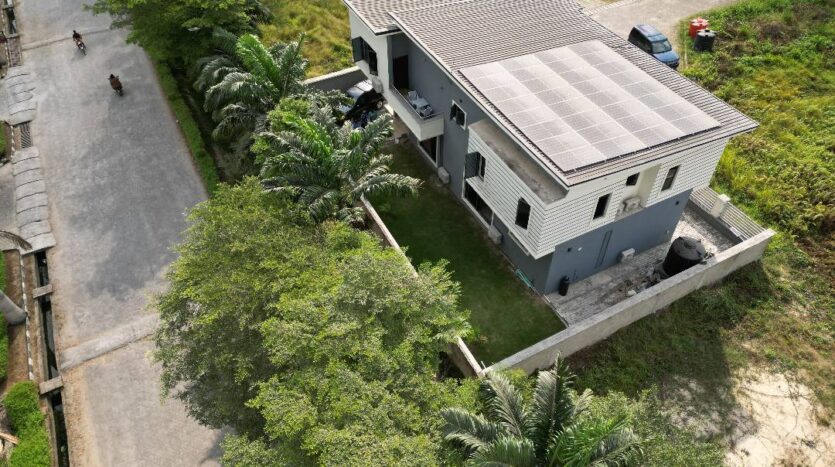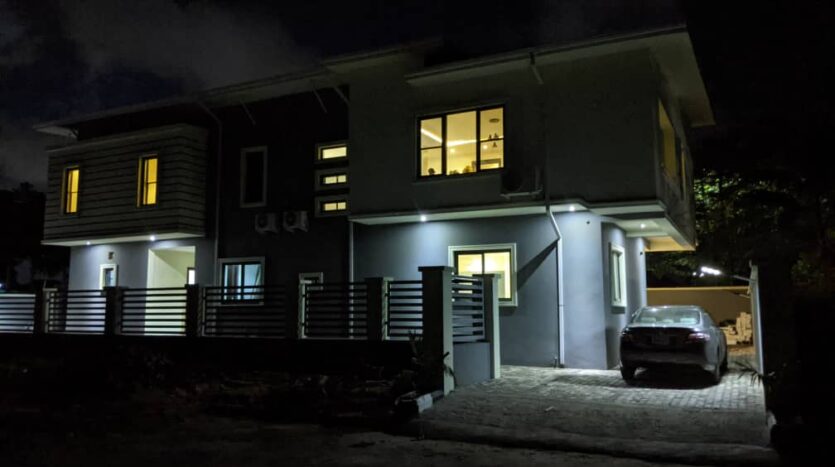Going completely off grid in Lekki, Lagos
Going completely off grid in Lekki, LagosNo PHCN? no generator?? No problem!!!
For our special solar power edition, we speak with a Nigerian gentleman who generates electricity from the sun. That is his only source of power supply which he has on a 24/7 basis. Is he a genius or a fantasist? Here is his story in his own words.
The subject property
I live in a single storey (ground and first floor) building in an estate at Sangotedo, Lekki. On the ground floor is a living cum dining space, a kitchen, store, power room and servants quarters. On the first floor is a family living room, spacious 2 bedrooms which share a toilet and shower, a box room and an ensuite master bedroom with walk-in wardrobe.
I will consider the house to be a ‘moderate’ or ‘restrained’ middle class residence, as many in the upper middle class would have gone for a 5 bedroom house with all rooms ensuite while I am absolutely comfortable with the arrangement where two bedrooms share a bathroom.
I moved fully into the house eleven months ago. I reside here with a house keeper most of the time but my family and friends (up to three additional persons) comes to stay now and again.
So how is it going completely off grid in Lekki, Lagos?
Configuration of the solar power system
I have 32 solar panels on my roof. They are 450watts each. By happy coincidence I have a flat roof that is suitable for the panels. Many houses in Nigeria have steep roofs that are more suitable in a climate with heavy snowfall but may not be appropriate for the solar panels to be affixed to them. I am also fortunate to have a south facing roof which apparently is important during certain times in the year to catch as much sunlight as possible.
Our first calculation is to multiply the 32 solar panels with the 450watts and then multiply that figure by 3 peak hours (11am -2pm). This gives sround 48kilowatt hours.
I have two solar controllers (Castles Lifestyle explanation: Solar Charge controllers or voltage regulators protect the batteries from overcharging, subsequent gassing, loss of electrolyte and possible plate damage.) The two solar controllers are connected to two separate sets of 16 solar panels. This is to create a failsafe arrangement in the event that one has an issue.
The two solar controllers supply power to three nos 5KVA inverter. Each inverter is linked to a different phase (Castles Lifestyle explanation: In electricity, the phase refers to the distribution of a load.) These inverters charge a total of 24 batteries. Once these batteries are fully charged, the power goes directly to the residence, thereby you have direct sun generated power.
The 24 batteries have a 1.2kilowatt hour capacity which means that when the batteries are fully charged, I have an approximate 28 kilowatt hour capacity. These batteries are lead acid, deep cycle, flooded batteries.
In the eleven months of using the system, I have seen the best and the worst. Only once during that period did the batteries reach 49% of their capacity but by 9am the following day, they had been charged to 100% and I resumed enjoying direct power from the sun. On two occasions, it took up to 5pm for the batteries to reach maximum charge of 100%. Two occasions in 11 months.
African Development Bank Abuja issues tender for Solar Plant Project
Household facilities and equipment
My residence has a total of ten air-conditioners (which I do not use at the same time). Most of the air-conditioners are the ‘inverter’ types with power saving of 60% – 80%. I also have 3 water heaters, Television, fans, lights, fridge, freezer, washing machine, a water pump and an iron. I do take some care to ensure that I purchase power efficient household equipment and also watch when I do certain chores – for instance, ironing and washing is always done during the day.
My background
No, I am not a physics major or electrical engineering genius. I did some science at school and was not particularly good at it. I studied economics at the University and ended up as a Chartered Accountant. So I don’t have any specialist scientific knowledge but must admit that I am very close to someone who is quite versed in this field. I am the kind of person who is intrigued by the fact that I will not need to change this equipment for the rest of my life and will not need to ever pay for power in this residence.
What I shall definitely change are the batteries. We have 1,200 cycles and I’ve only used 50 in 11 months. For batteries it’s a matter of capacity balancing/management. If you have an idea of your load, size your battery bank to accommodate that load.
You could buy lithium batteries, which are more expensive but will last you up to 20 years.
Maintenance
The basic maintenance is that I have to top up the batteries with distilled water. I have calculated this to be twice or thrice a year as I have monitored the system for over 11 months. The inverters and solar controllers have been cleaned once but most of the dirt was from construction debris and dust. The system’s performance can be read online so the installers can track its performance and take preventive action when required. For the solar panels, I rely on the good old tropical rain to wash them.
Cost, returns and savings
My system cost between $25,000 and $30,000 because I went for the Victron Brand of inverters – these are the ‘Rolls Royce’ of inverters. I used a Victron inverter in my previous residence for 15 years with minimal issues. Costing varies due to capacity, architecture, vendor and brand. I used Komponents and Solutions Rack who are Victron reps in Nigeria.
On savings, I have computed that I have generated 7,300 kilowatt hours of power in the last 11 months and this multiplied by say N100/kilowatt hours means a ‘savings’ of N730,000.
There are other hidden savings like the voltage being rock steady. You don’t have to worry about power surges unlike my neighbour who had his TV blown by power from the grid which set him back N500,000.
Mistakes
I would have preferred to have invested in OPz batteries (Castles Lifestyle explanation: OPzS is used to refer to a flooded type of tubular-plated, lead acid deep cycle batteries. These batteries generally have a cell voltage of 2 volts and are connected in series to produce higher voltages). Because they last longer – some people have used them for over 13 years. Also, I got standalone solar lights for my perimeter fence but I should have hooked the lights directly to the main system
Final words
I can also stay at home all day, working, or relaxing without the niggling worry that it is costing me a kobo. The psychological assurance that your power will not be cut arbitrarily at any moment is so satisfying. No matter how much power goes up by in the future, my wallet is immune.
Nigeria is an energy rich but fuel poor country. We have an abundance of crude oil, sunlight, gas, hydro opportunities as a comparative advantage. The amount of sunlight that hits the earth’s surface in one hour if efficiently utilised can power the world’s energy needs for one year. By the NEEDS document, Nigeria is a gas province with few deposits of oil. The sky is the limit. Things can get better, but we need to work towards it and reorder our priorities from the get go. Postpone that swimming pool, scrap the idea for a central air-conditioning system, insulate via windows and walls, create a cool building for power efficiency. Distinguish between needs and wants.
Good Luck!!!





Omo, na Man you be! Wait small, we’ll join you there.
You would have used lithium batteries.zero maintenance and a workhorse
Thank you.
The solution for lead acid battery had the consideration of cost vs life expectancy. Life expectancy was influenced by sizing anticipated power requirement. In other words, the cost effectiveness of a relatively less stressed lead acid battery bank vs a significantly costlier li-on bank. Those variables brought us here. Maintenance via distilled water vs the time value of the additional cost the li-ion battery bank.
I’m anticipating there will improvements that will be more cost advantageous, and more efficient in battery technology at the next bus stop (replacement)
Those were the considerations.